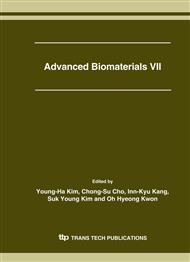p.893
p.897
p.901
p.905
p.909
p.913
p.917
p.921
p.925
Prediction of Intraosseous Pressure Behavior to Understand Strain Generated Potential near Osseointegrated Bone and Implant Composite
Abstract:
Osseointegration (OI) could be described as the modality for stable fixation of titanium implant to bone structure. The OI has become a realized phenomenon of importance in the dental and rehabilitation sciences since recently developed dentures and artificial limbs are directly attached to human skeleton by using osseointegrated implants. Previously, a study showed that bone strain generated potential (SGP) that is an electrical potential and considered to be generated by fluid flow in bone could be used as a parameter to examine the amount of OI on implant-bone interface. SGP generation is known to require intraosseous fluid flow related with generations of pore pressure gradient in bone. Therefore, SGP would interact with properties determining interstitial fluid flow characteristics such as viscosity, velocity, flow path directions, and interstitial fluid flow boundary conditions. Since interstitial fluid flow characteristics in bone are governed by pore pressure gradient, it could be possible to predict SGP indirectly through the prediction of pore pressure generation in bone. The aim of this study is to predict the distribution of pore pressure in OI bone-implant composite representing a completely osseointegrated rabbit tibia-titanium implant composite. The theoretical background of this prediction is based on the poroelasticity of 2-phase material that grounds on fluid flow and behavior of cortical bone material. In this study, we constructed a finite element (FE) model of the composite from images of micro-CT scanning. In the next step, we examined analysis of the FE model about pore pressure by using ABAQUS. In this analysis, the constitutive behavior was externally computed by utilizing a user subroutine. The results showed the different spatial distributions of pore pressure in the composite. The magnitudes of pore pressure were found to be significantly increased when the position was approached for the interface of implant-bone. Further analytical study is required to fully understand relationships between SGP and pore pressure distributions in OI bone-implant composite materials.
Info:
Periodical:
Pages:
909-912
Citation:
Online since:
July 2007
Authors:
Price:
Сopyright:
© 2007 Trans Tech Publications Ltd. All Rights Reserved
Share:
Citation:


